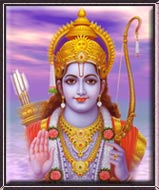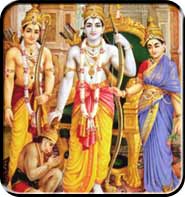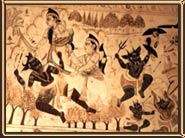INTRODUCTION

TIME OF COMPOSITION
Like many other classical poems written in ancient times, the exact date and time of the genesis of Ramayana is yet to be determined accurately. There was a long period of oral tradition before the Ramayana was actually written, and the original content of the story is based on various pre-existing folk tales about Rama. The reference to the Greeks, Parthians, and Sakas shows that the time of composition of Ramayana cannot be earlier than the second century B.C. But the consensus is that Ramayana was written between the 4th and the 2nd centuries B.C. with augmentations up to about 300 C.E. Linguistically and philosophically, a period just after the Vedic age, would most suit the content of the epic.STORY OF RAMAYANA
Rama was the virtuous eldest son of Dasharatha, king of Ayodhya. Dasharatha was born in the line of Ikshvaku ("the first king of the Ikshvaku dynasty and founder of the Solar Dynasty of Kshatriyas in Vedic civilization in ancient India"). Born to Kaushalya, the chief queen of Dasharatha, he automatically became the crown prince. He deeply loved his half brothers, the twins Laxmana and Shatrughana, born to queen Sumitra, and Bharatha, born to queen, Kaikeyi. The family guru, Vashistha taught them all the art of arms. When Rama was sixteen, on the request of the great Vishwamitra, Dasharatha sent Rama and Lakshmana to the forest to defend Vishwamitra's rituals from vicious demons which they devotedly performed.
In the meantime the grieved Dasharatha died. Rama lived in a small hut with Sita and Lakshmana in Panchavati in the Dandakavana. Ravana, the mighty king of Lanka, under the ill- gotton advices of his sister Surpanaga, kidnapped Sita to Lanka. Rama and Laxmana in their attempt to rescue her, met with so many hardships and with the help of their friends like monkey- king Sugriva, Hanuman and along with Sugriva's army invaded Lanka. After Ravana lost all his men including his brothers and son he himself came to battlefield. Insppite of the deadly weapons he used against Rama and Laxmana but none of them could hurt them because they had truth and justice on their side. At last Ravana was killed and Rama and Sita were reunited. After the expiry of 14 years of exile Rama along with Sita and Laxman returned to Ayodhya. The whole of Ayodhya became jubilant. On an auspicious day Rama was crowned the king of Ayodhya.
The story starts with the childhood of Rama and describes his entire life history. Through the character of Rama, an elaborate emphasis and significance is bestowed on moral, ethical and humanitarian values.
ABOUT THE COMPILATION
This great epic is composed of rhyming couplets called 'slokas', employing a complex meter called 'anustup'. These verses are grouped into individual chapters called 'sargas', wherein a specific event or intent is told. The 'sargas' are again grouped into books called 'kandas'. The seven 'kandas' of Ramayana are:Bal Kanda (the boyhood section)
Ayodhya Kanda (Rama's life in Ayodhya, until his banishment)
Aranya Kanda (Rama's life in the forest and Sita's abduction by Ravana)
Kishkindha Kanda (Rama's stay at Kishkindha, the capital of his monkey ally, Sugriva)
Sundara Kanda (Rama's passage to Sri Lanka)
Yuddha Kanda or Lanka Kanda: (Rama's battle with Ravana, the recovery of Sita, and return to Ayodhya)
Uttara Kanda (the section narrating Rama's life in Ayodhya as king, the birth of his two sons, Sita's test of innocence and return to her mother, and Rama's demise or 'jala samadhi' (water- tomb)).The Uttara Kanda is regarded to be a later addition to the original story by Valmiki.
VERSIONS AND TRANSLATIONS



